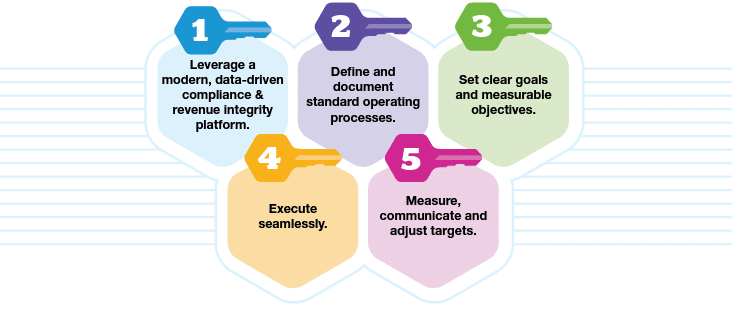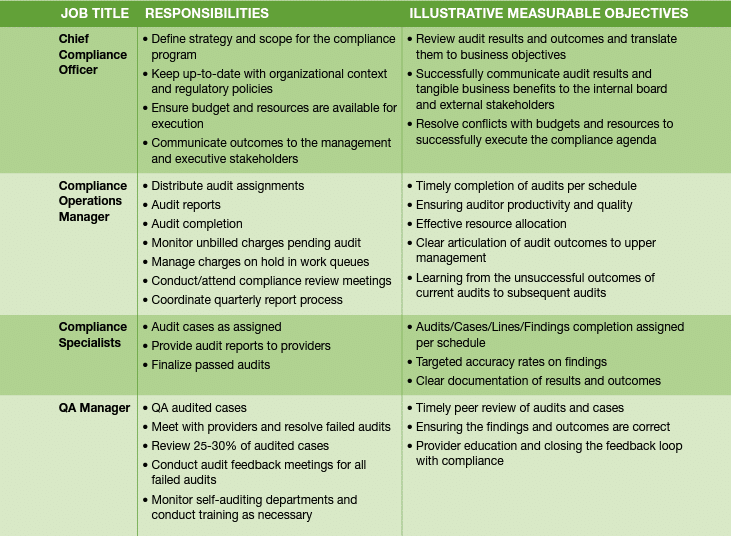Increased compliance demands and reduced staff resources in the healthcare industry have heightened focus on improving the productivity of audit teams. Doing more with less has become an inevitable mantra for auditing groups in healthcare organizations striving to minimize overall risk and stay ahead of third-party regulatory entities.
The concept of productivity is often viewed negatively—a way to simply wring out more output from overworked staff. That doesn’t have to be the case. Enlightened managers can dramatically improve the amount of work being performed through increased efficiency and use of the latest technology tools.
There are five keys to driving audit productivity in the increasingly regulated and competitive healthcare industry.
- Leverage a modern, data-driven compliance and revenue integrity platform
- Define and document standard operating processes
- Set clear goals and measurable objectives
- Execute seamlessly
- Measure, communicate and adjust targets
Key 1: Leverage a modern, data-driven compliance & revenue integrity platform.
The Challenge
The number and scope of audit requirements in the healthcare industry makes manual auditing unfeasible. Your audit staff would need to be expanded exponentially to comb through mountains of claims and billing data to uncover risks or trends that could expose your organization to financial penalties.
The Solution
To keep up with an increased audit workload, your compliance organization needs tools that streamline and automate auditing and compliance efforts. A modern and effective compliance and revenue integrity technology platform that runs in the cloud and has augmented intelligence capabilities allows you to quickly analyze and measure your organizational risk, monitor specific risk profiles, target your audits, and focus quality initiatives and education around findings. Having a single platform with integrated workflows and analytics functionality will ensure that billing, compliance, and revenue cycle stakeholders can collaborate and share insights to tackle both compliance and revenue challenges. The technology also
allows auditors to spend more time on provider education and revenue capture opportunities for their organization.
The modern technology platform offers a significant opportunity to grow your auditing program efficiently while ensuring that quality and positive outcomes can be achieved. The two most significant components worth noting are:
Cloud-Based Solutions
- Offer rich functionality that allows features to be updated frequently and seamlessly by your vendor.
- All the infrastructure maintenance, upgrades and security patches are managed by the vendor saving you money and resources.
- Greater opportunity for usage of innovative technologies to drive business outcomes.
Augmented Intelligence Capabilities
- Actionable insights that are easy to use for executives, mid-level management and data analysts to identify and mitigate risks.
- Aggregate, filter, detect anomalies and drill down on any attribute to the most granular data in seconds over millions of rows of data.
- Machine learning based forecasting models and anomaly detection features to proactively catch issues before they occur.
- Ability to benchmark results compared to industry standards and peer organizations.
Most importantly, once you have implemented an auditing solution, you must commit to utilizing it fully. Use all the available features and leverage the reporting built into your system. Eliminate any offline spreadsheet tools and processes that slow things down.
Step 2: Define and document standard operating processes.
Ensuring everyone is performing the same tasks, in the same way, is a critical step in achieving maximum efficiency. Adequately train your staff on your auditing software and the processes needed to be successful so everyone is using the system properly.
Effective processes include:
- Defining a dynamic and robust audit scope based on industry trends, benchmarking data and evidence.
- Running system reports to parse out daily and weekly audit assignments to balance the workload.
- Committing to QA all audits by the following workday.
- Using common templates and established procedures.
- Establishing timelines for routine audits, re-audits for providers with findings, and audit feedback loops.
- Developing an audit escalation process for moving from routine to focused, intensive, and prospective audits.
- Ensuring all activities are conducted and documented in your auditing software system.
If you have both a central audit team and auditors assigned to specific departments, make sure everyone is auditing to the same overall compliance plan.
Audit feedback processes are particularly important and should include:
- Email notification for passed audits
- Face-to-face or phone meetings for failed audits
- Presentation of both positive and negative findings
- Simplified, easy to understand summary reports
- Clearly defined metrics and KPIs to ensure everyone is measured consistently
Step 3: Set clear goals and measurable objectives.
Efficient audit teams understand the importance of being organized. Clearly defining the tasks and measurable objectives of everyone on the team is a critical first step.
A typical audit team, their responsibilities, and their objectives could include:
To coordinate the activities of the team, it’s helpful to use a single enterprise auditing platform. This allows you to perform logistics and operations planning, review workloads, review pending audit cases, distribute daily and weekly assignments, and provide a big picture for the entire team.
Step 4: Execute seamlessly.
Creating an environment of productivity and quality requires working with the team to set appropriate expectations. Start by evaluating activity data and conducting actual time studies. Incorporate the best practices of high performers to optimize your processes. Set specific goals for each task to encourage healthy competition.
These benchmarks could include key metrics such as:
- Number of audits/cases/lines/fields to be audited per week/month/audit period
- Field accuracy/procedure accuracy/group accuracy per week/month/audit period
- Number of audited cases to be QA’d per week/month/audited period
- Dollar amount of unbilled charges pending audit
- Dollar amount of charges on hold in work queues
- Timeframe to resolve audits findings
- Tracking disagree findings on various CPT/HCPCS/Modifiers/ICD-10 codes to learn for the next audit
- Comparative reports for over coding and under coding for provider education
To monitor activity and compare to productivity goals, have auditors submit a summary of daily activity including number of cases pending, number of cases audited, status of audited cases, cases on hold, and audit follow-up activity. For managers, the report should track number of cases QA’d and other activity performed such as provider meetings or training sessions. Tracking activity in this way helps team members understand where they are excelling and where they may need to improve.
Step 5: Measure, communicate and adjust targets.
One of the most important keys to driving productivity and quality is to hold everyone accountable – both to management and to each other. In a healthcare organization, producing measurable results is an expectation. Physicians are now being held to standards of productivity, performance, and quality. Managers must present audit productivity dashboards to internal stakeholders and leadership. Similarly, it is reasonable that compliance and audit staff should be held to established productivity standards.
Do not forget, the primary responsibility for the success of your auditing team starts at the top. Chief Compliance Officers must ensure that the audit teams have the requisite budget, platform, and processes to execute on the compliance agenda. Without the full support of the C-suite, auditing teams will struggle to fulfill their full potential.
Consider the following strategy that drives accountability.
Measure Results
At the end of each auditing period, review the results of your efforts.
- Compare results to the prior period
- Compare results to the established goals and measures Identify the good, the bad, and areas for improvement.
Dive into the data to understand any anomalies and prepare a narrative that can be shared.
Communicate Results
Once your measurements are complete, it is time to share.
- Provide results upwards to your management team. Highlight success and provide insights around problems. Be transparent about challenges your team may need help with.
- Spend time with individual contributors to review their personal results and their performance against expectations.
Adjust Targets Through the process of measuring and communicating the results of the auditing team, it may become apparent that goals need to change. Perhaps new software makes it easier for the team to be effective, allowing you to increase the goals. Or new goals can be introduced based on the performance seen.
Productivity and quality are the inevitable result of everyone involved pulling in the same direction to meet established goals and drive efficiency into the audit process. Establishing that kind of cooperative environment can result in achieving the high levels of productivity required to survive in the challenging healthcare environment.
The 5 Keys to Driving Audit Productivity, Quality and Outcomes
Benjamin Franklin is credited with saying “If you fail to plan, you are planning to fail!” When an auditing team plans for their success, not only will they be successful at detecting compliance and billing risk, they will also provide value to the organization through their positive contributions to revenue flow. The five keys to driving audit productivity, quality and outcomes may seem simple. The reality is that it takes careful planning and commitment from the top down to achieve success.
MDaudit Enterprise Can help
Measure, communicate and adjust targets. The MDaudit Enterprise platform offers robust auditing workflows, advanced analytical capabilities with AI powered insights and the ability the dive down into the performance of your auditing team and individual contributors.








